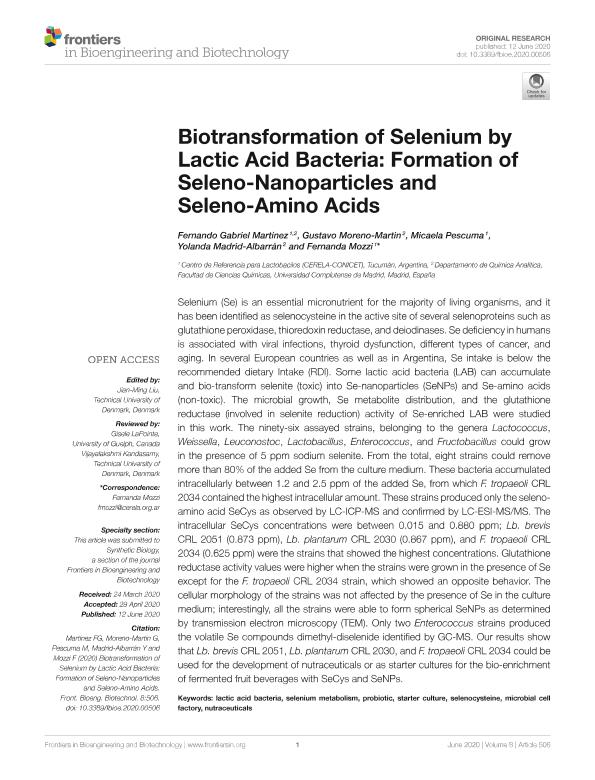Mostrar el registro sencillo del ítem
dc.contributor.author
Martínez, Fernando Gabriel

dc.contributor.author
Moreno Martin, Gustavo
dc.contributor.author
Pescuma, Micaela

dc.contributor.author
Madrid Albarrán, Yolanda
dc.contributor.author
Mozzi, Fernanda Beatriz

dc.date.available
2021-09-02T19:11:19Z
dc.date.issued
2020-06
dc.identifier.citation
Martínez, Fernando Gabriel; Moreno Martin, Gustavo; Pescuma, Micaela; Madrid Albarrán, Yolanda; Mozzi, Fernanda Beatriz; Biotransformation of Selenium by Lactic Acid Bacteria: Formation of Seleno-Nanoparticles and Seleno-Amino Acids; Frontiers Media S.A.; Frontiers in Bioengineering and Biotechnology; 8; 6-2020; 1-17
dc.identifier.uri
http://hdl.handle.net/11336/139567
dc.description.abstract
Selenium (Se) is an essential micronutrient for the majority of living organisms, and it has been identified as selenocysteine in the active site of several selenoproteins such as glutathione peroxidase, thioredoxin reductase, and deiodinases. Se deficiency in humans is associated with viral infections, thyroid dysfunction, different types of cancer, and aging. In several European countries as well as in Argentina, Se intake is below the recommended dietary Intake (RDI). Some lactic acid bacteria (LAB) can accumulate and bio-transform selenite (toxic) into Se-nanoparticles (SeNPs) and Se-amino acids (non-toxic). The microbial growth, Se metabolite distribution, and the glutathione reductase (involved in selenite reduction) activity of Se-enriched LAB were studied in this work. The ninety-six assayed strains, belonging to the genera Lactococcus, Weissella, Leuconostoc, Lactobacillus, Enterococcus, and Fructobacillus could grow in the presence of 5 ppm sodium selenite. From the total, eight strains could remove more than 80% of the added Se from the culture medium. These bacteria accumulated intracellularly between 1.2 and 2.5 ppm of the added Se, from which F. tropaeoli CRL 2034 contained the highest intracellular amount. These strains produced only the seleno-amino acid SeCys as observed by LC-ICP-MS and confirmed by LC-ESI-MS/MS. The intracellular SeCys concentrations were between 0.015 and 0.880 ppm; Lb. brevis CRL 2051 (0.873 ppm), Lb. plantarum CRL 2030 (0.867 ppm), and F. tropaeoli CRL 2034 (0.625 ppm) were the strains that showed the highest concentrations. Glutathione reductase activity values were higher when the strains were grown in the presence of Se except for the F. tropaeoli CRL 2034 strain, which showed an opposite behavior. The cellular morphology of the strains was not affected by the presence of Se in the culture medium; interestingly, all the strains were able to form spherical SeNPs as determined by transmission electron microscopy (TEM). Only two Enterococcus strains produced the volatile Se compounds dimethyl-diselenide identified by GC-MS. Our results show that Lb. brevis CRL 2051, Lb. plantarum CRL 2030, and F. tropaeoli CRL 2034 could be used for the development of nutraceuticals or as starter cultures for the bio-enrichment of fermented fruit beverages with SeCys and SeNPs.
dc.format
application/pdf
dc.language.iso
eng
dc.publisher
Frontiers Media S.A.

dc.rights
info:eu-repo/semantics/openAccess
dc.rights.uri
https://creativecommons.org/licenses/by/2.5/ar/
dc.subject
LACTIC ACID BACTERIA
dc.subject
MICROBIAL CELL FACTORY
dc.subject
NUTRACEUTICALS
dc.subject
PROBIOTIC
dc.subject
SELENIUM METABOLISM
dc.subject
SELENOCYSTEINE
dc.subject
STARTER CULTURE
dc.subject.classification
Biología Celular, Microbiología

dc.subject.classification
Ciencias Biológicas

dc.subject.classification
CIENCIAS NATURALES Y EXACTAS

dc.title
Biotransformation of Selenium by Lactic Acid Bacteria: Formation of Seleno-Nanoparticles and Seleno-Amino Acids
dc.type
info:eu-repo/semantics/article
dc.type
info:ar-repo/semantics/artículo
dc.type
info:eu-repo/semantics/publishedVersion
dc.date.updated
2021-08-27T20:20:35Z
dc.identifier.eissn
2296-4185
dc.journal.volume
8
dc.journal.pagination
1-17
dc.journal.pais
Suiza

dc.journal.ciudad
Lausana
dc.description.fil
Fil: Martínez, Fernando Gabriel. Universidad Complutense de Madrid. Facultad de Ciencias Químicas. Departamento de Química Analítica; . Consejo Nacional de Investigaciones Científicas y Técnicas. Centro Científico Tecnológico Conicet - Tucumán. Centro de Referencia para Lactobacilos; Argentina
dc.description.fil
Fil: Moreno Martin, Gustavo. Universidad Complutense de Madrid. Facultad de Ciencias Químicas. Departamento de Química Analítica;
dc.description.fil
Fil: Pescuma, Micaela. Consejo Nacional de Investigaciones Científicas y Técnicas. Centro Científico Tecnológico Conicet - Tucumán. Centro de Referencia para Lactobacilos; Argentina
dc.description.fil
Fil: Madrid Albarrán, Yolanda. Universidad Complutense de Madrid. Facultad de Ciencias Químicas. Departamento de Química Analítica;
dc.description.fil
Fil: Mozzi, Fernanda Beatriz. Consejo Nacional de Investigaciones Científicas y Técnicas. Centro Científico Tecnológico Conicet - Tucumán. Centro de Referencia para Lactobacilos; Argentina
dc.journal.title
Frontiers in Bioengineering and Biotechnology
dc.relation.isreferencedin
info:eu-repo/semantics/reference/url/http://hdl.handle.net/11336/40073
dc.relation.alternativeid
info:eu-repo/semantics/altIdentifier/url/https://www.frontiersin.org/articles/10.3389/fbioe.2020.00506/full
dc.relation.alternativeid
info:eu-repo/semantics/altIdentifier/doi/http://dx.doi.org/10.3389/fbioe.2020.00506
Archivos asociados
